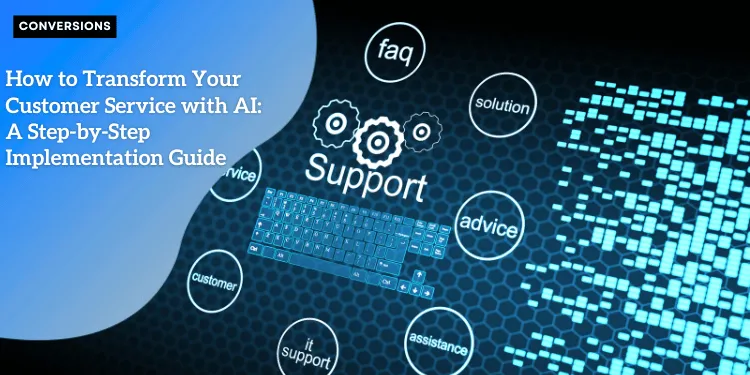How to Transform Your Customer Service with AI: A Step-by-Step Implementation Guide

Anúncios
Modern Customer Service: An Omnichannel Operation
Customer service has significantly evolved over the past decade.
It’s no longer confined to traditional methods like phone calls and emails.
Today, it spans across a variety of platforms, including live chat, social media, and mobile apps.
This omnichannel approach allows businesses to meet customers wherever they are, providing seamless service across various touchpoints.
Anúncios
However, managing this complex web of interactions requires sophisticated systems.
Traditional support setups often struggle to keep pace with the demands of an omnichannel operation.
This is where AI steps in, enabling businesses to handle these intricate workflows efficiently.
Anúncios
AI: Transforming Traditional Support
Artificial Intelligence is revolutionizing customer service by bringing automation and enhanced efficiency to the forefront.
AI-powered systems can process vast amounts of data to provide quick, accurate responses to customer inquiries.
For instance, AI chatbots can instantly answer common questions like “Where is my order?” or “Can I return this product?” Such queries often constitute up to 80% of total customer interactions, making automation a game-changer for operational efficiency.
By integrating AI into customer service workflows, businesses can significantly reduce response times and operational costs.
AI systems work around the clock without the need for human intervention, ensuring 24/7 support availability.
This not only improves customer satisfaction but also allows human agents to focus on more complex and high-value tasks.

Automation of Routine Inquiries
A substantial amount of customer inquiries are routine and can be easily automated.
AI assistants and chatbots can handle tasks such as order tracking, shipment updates, and basic troubleshooting.
By automating these repetitive tasks, companies can streamline their support processes, making them more efficient and cost-effective.
This automation frees up human agents to tackle more nuanced and emotionally charged issues that AI currently struggles to manage.
As a result, businesses can ensure that their customers receive the right level of care and attention, balancing the efficiency of AI with the empathy and judgment of human interaction.
Transition to Hybrid Models
While AI provides tremendous benefits, it is not without its limitations.
AI systems may falter when faced with complex scenarios requiring empathy and nuanced handling.
Therefore, the most effective customer service strategies combine AI with human expertise.
This hybrid model ensures that routine inquiries are handled promptly by AI, while human agents are available to manage more complicated or sensitive issues.
The evolution of customer service in the AI era is about striking the right balance between automation and the irreplaceable value of human touch.
By adopting this approach, businesses can maximize efficiency, optimize customer satisfaction, and maintain a competitive edge in an increasingly digital world.
By understanding these evolving dynamics, businesses can prepare for the next step: implementing AI to unleash its full potential.
Key Benefits of AI-Powered Customer Support
24/7 Customer Service Availability
One of the most significant advantages of AI in customer support is the ability to offer around-the-clock service without additional staffing costs.
This continuous availability ensures that customer inquiries are addressed promptly, regardless of the time of day.
Unlike human agents who need breaks and adhere to standard working hours, AI-driven chatbots and virtual assistants can work uninterrupted.
This capability is particularly beneficial for businesses with a global customer base requiring support across different time zones.
Reduced Operational Expenses
Implementing AI in customer service can lead to substantial cost savings.
By automating up to 80% of routine inquiries, businesses can reduce the need for extensive staffing, thereby cutting labor costs.
Moreover, AI-powered systems can handle multiple queries simultaneously without compromising on response quality.
This efficiency translates to lower operational expenses while maintaining a high level of customer satisfaction, which studies have shown to increase by 20%.
Improved Efficiency
AI excels at automating repetitive tasks, which allows human agents to focus on more complex issues and high-value activities, such as customer retention and upselling.
Automating routine queries like “Where is my order?” and “Can I return this product?” frees up human agents to apply their problem-solving skills to more challenging and nuanced customer concerns.
This not only improves overall efficiency but also enhances the customer experience by ensuring that customers receive timely and effective resolutions.
By integrating AI into your customer service strategy, you can streamline operations, reduce costs, and improve satisfaction.
These tangible benefits make AI an indispensable tool for modern customer support systems.
To effectively implement AI, it is crucial to understand its capabilities and limitations, ensuring that it works harmoniously with human agents.
This balance will foster an optimized support environment that combines efficiency with empathetic human interaction.
Moving ahead, exploring the potential challenges and the importance of a hybrid AI-human model will further illustrate an optimal approach to customer service transformation.
Understanding AI’s Limitations in Customer Service
AI Struggles with Nuanced and Emotionally Charged Interactions
Artificial Intelligence (AI) has revolutionized customer service in many ways, but it’s important to recognize its limitations.
One significant challenge AI faces is handling nuanced and emotionally charged customer interactions.
AI can process and respond to straightforward questions like “Where is my order?” but it struggles with complex language and emotional subtleties.
For example, if a customer is frustrated about a delayed shipment, an AI might not be able to convey empathy or provide a contextually appropriate response, potentially leading to customer dissatisfaction.
The Importance of Maintaining Human Touch for Complex Customer Concerns
Maintaining a human touch in customer service remains crucial for addressing complex or sensitive issues.
Human agents bring empathy, creative problem-solving, and the ability to handle unique, unanticipated concerns.
When customers face issues that go beyond routine inquiries, they often seek reassurance and personalized solutions that only a human can effectively provide.
This human element is vital for building strong customer relationships and achieving higher satisfaction rates.
Why a Hybrid Model is the Optimal Solution
Given these limitations, a hybrid model that combines AI and human agents is often the best approach for customer service.
In this model, AI handles repetitive and routine tasks, such as common questions and order tracking.
This allows human agents to focus on more complex and emotionally nuanced issues.
By leveraging the strengths of both AI and human agents, businesses can boost efficiency and ensure a high-quality customer experience.
The hybrid model not only improves operational efficiency but also enhances the overall customer service experience by ensuring that emotionally charged and complex concerns are adequately addressed by human agents.
Integrating AI into customer service workflows allows businesses to provide round-the-clock support while maintaining the necessary human touch for more intricate issues.
Balancing automation with human interaction is a key factor in sustaining a positive customer experience and achieving long-term success in customer service.
Step-by-Step Implementation Guide
How to Audit Your Current Customer Service Workflow
To kickstart your AI transformation, perform a thorough audit of your current customer service workflow.
Identify the repetitive and routine tasks that consume time and resources.
Common examples include tracking order status, answering frequently asked questions, and handling basic returns.
These tasks are perfect candidates for automation, allowing human agents to focus on more complex issues.
Auditing Steps:
| Step | Description |
|---|---|
| 📝 Map Out Your Workflow | Document all touchpoints from when a customer inquiry comes in to when it is resolved. This helps ensure that every step of the process is clear and optimized for efficiency. |
| 🔄 Identify Routine Tasks | Pinpoint inquiries that are repetitive and could be standardized. These tasks can be automated or streamlined to improve efficiency and free up time for more complex issues. |
| 🛠️ Assess Existing Tools | Evaluate if your current systems can integrate with AI technology. This ensures that your existing tools can be enhanced with automation and AI to improve the support process. |
Selecting the Right AI Tools and Platforms
Once you’ve identified opportunities for automation, the next step is to choose the right AI tools and platforms.
Not all AI solutions are equal, so selecting one that aligns with your specific needs is crucial.
Recommended Criteria:
- Ease of integration: Ensure the tool works seamlessly with your existing systems.
- Scalability: Choose a platform that can grow with your business needs.
- User-friendly interface: Both your team and your customers should find the tool easy to use.
Consider popular platforms like Zendesk, Drift, and Intercom, which are known for their robust capabilities and ease of integration within ecommerce workflows.
Establishing Effective Training Programs
For AI to work effectively alongside human agents, you need comprehensive training programs.
Training Components:
- AI Overview: Educate staff about how AI works and the value it brings.
- Tool Training: Provide in-depth training on the chosen AI platforms.
- Team Collaboration: Focus on seamless handoffs between AI and human agents to ensure a smooth customer experience.
By following these steps, you’ll set a strong foundation for integrating AI into your customer service.
This approach frees your team to handle more complex, emotionally nuanced tasks, enhancing overall efficiency.
Keeping these insights in mind will pave the way for long-term success in AI-powered customer service.
Best Practices for Long-term Success
Building and Maintaining a Comprehensive Knowledge Base
A robust knowledge base is vital for the success of AI-powered customer support.
It ensures your AI has access to accurate, organized, and up-to-date information to answer customer inquiries effectively.
Start by curating a repository of common customer questions and detailed answers.
Regularly update this repository to reflect new products, services, and frequently asked questions (FAQs).
Keeping your knowledge base current is a continuous process. Designate a team to monitor and add new content regularly.
The more comprehensive your knowledge base, the better your AI can assist customers, enhancing both the AI’s reliability and your customers’ satisfaction.
Starting Small and Scaling Based on Feedback and Results
When implementing AI in customer service, one of the most successful strategies is to begin with a small pilot project.
Identify specific, routine tasks that AI can efficiently automate, such as responding to the common question, “Where is my order?” or handling simple return requests.
Launch this pilot project and gather feedback from both customers and support staff. Use this feedback to refine the AI systems.
Gradually expand the scope of AI integration, focusing on areas where the initial implementation proved effective.
This scalable, feedback-driven approach minimizes risks and allows you to make data-informed decisions about broadening AI use within your customer service operations.
Balancing Automation with Human Interaction for Optimal Customer Experience
While AI excels in handling routine inquiries, it falls short in situations requiring emotional intelligence.
Thus, the key to long-term success is balancing automation with human interaction.
Implement AI to manage repetitive tasks, freeing human agents to deal with complex and emotionally nuanced issues—where empathy and thoughtful problem-solving are indispensable.
Adopt a hybrid model where AI and human agents seamlessly collaborate.
Ensure AI can escalate complex problems to human agents smoothly.
Train your human agents to take over and resolve issues adeptly.
This combined approach not only improves efficiency but also enhances customer satisfaction by retaining the human touch in handling sensitive matters.
By maintaining a comprehensive knowledge base, starting small, scaling based on results, and managing the balance between automation and human interaction, you’ll be well on your way to achieving long-term success in AI-powered customer service.
Next, it’s essential to understand how AI integrates with specific business goals and objectives, ensuring alignment throughout your organization.
Remember, the key to seamless integration lies in continuous improvement and adaptation, ensuring that all components work harmoniously towards delivering exceptional customer service.
